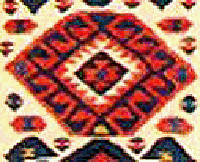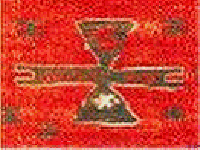Your Cart is Empty
Ücretsiz Hızlı Kargo & Koşulsuz İade ve Değişim
Menu

Ücretsiz Hızlı Kargo & Koşulsuz İade ve Değişim
Rug Motifs and Meanings
November 06, 2020 6 min read

Rug Motifs and Meanings
Since its existence, human beings need to tell about their feelings, life, values, ideas, daily life, past and dreams. People of every region and every period transfer this to their art by using the resources they have. The canvas of the Anatolian people is the rugs from Çatalhöyük to this time, and what they tell is hidden in the motifs that touch these rugs. Here are some carpets rug motives and meanings:

-
Scorpion Motif
Rug motifs in the form of scorpions, which are among the motifs embroidered for protection, symbolize the demonic spirit. This scorpion always lurks to kill. It represents causeless quarrels and bad intentions. Anatolian people, who use a piece or pattern of whatever they fear, to avoid it, also to avoid harmful creatures. in carpets and rugs It uses the scorpion motif.

-
Plus Motif and Hook Motif
Plus and hook are frequently encountered motifs among Turkish carpet motifs. The cross motif has nothing to do with the Christian cross symbol. It is known that it is used to protect from trouble and dangers.

-
Abundance Motif
Rug patterns known as fertility motifs can be evaluated in three groups. In the first group; There are fruits such as pomegranates, grapes, melons, watermelons, figs, mulberries, and animals such as dragons, bulls, snakes, rams, butterflies, deer, and fish, and they symbolize immense happiness. In the second group; leaves, flowers and tree motifs are present and symbolize abundance and auspiciousness. In the third group; There are natural beings such as water, rocks, mountains, and they represent the universe, its movement and structure, as well as birth, death and rebirth.

-
Bukağı Motif

Dragon/Dragon Motif
The dragon is a giant snake symbol with wings, its claws reminiscent of a lion, its tail resembling a snake. He is the lord of water and air and the keeper of hidden treasures. With the intention of meeting the bountiful spring rain carpets and rugs touches.

Hand on Waist Motif
The widely used hand on waist motif represents femininity, fertility, fortune, joy, auspiciousness, happiness and fertility. It is known that the first humans regarded the mother goddesses as sacred and worshiped them because they thought that reproduction was a process that belonged only to the females and did not know the male's contribution to reproduction. The origin of this motif, which continues to be used in carpet weaving today, is based on this belief about mother goddesses.

-
Eye Pattern
Rug patterns in the form of eyes, embroidered as a precaution against the evil eye, are usually woven with the striking blue color. Rug It is frequently used in or around the hand on the waist, coach horn and fertility motifs. In addition to being used for protection from evil eyes, it is also the symbol of intellectual gaze, deep perception and spiritual enlightenment, such as the eye called the "eye of the heart" and the "third eye" located on the forehead of Shiva, one of the Gods of Buddhism.

-
Tree of Life Motif
The tree of life motif, true to its name, symbolizes the universe that continues to live by constantly developing and changing. Its roots connected to the ground represent rooting, eternity and resilience. It extends to heaven with its lower branches and trunk, and to heaven with its upper branches, and unites heaven and earth. Trees such as pomegranate, date, olive, fig, cypress, beech, cedar, oak, palm and vine symbolize the tree of life. The birds on these trees, on the other hand, represent lifebirds that leave when the time comes.

-
Mark and Stamp Motifs
It is known that throughout history, Turks used certain figures, signs and stamps to describe concepts such as tribe, oba, state, and tribe. These stigmas and marks represent the existence of society or person. The purpose of this is to preserve the family name and lineage, as well as to protect the family's valuables. Each weaving transfers the tools, goods and culture of that society to new generations. Today's logos, nicknames and pictograms are also associated with this tradition.

-
Human Motif
When the meanings of rug motifs and the emotions of the weaver are combined, they describe the current situation. Motifs using human patterns often point to longing. In some weavings, it is a motif that symbolizes the beloved who is abroad and wants to see, and in others, it symbolizes a girl or a boy. It tells the longing of the weaver or the expectation of a child. It is also a symbol of creativity and hard work.

-
Eagle Motif
The eagle, which has an important place in the history of the Turks, is seen as the symbol of the sky, the messenger of the future and a holy official who takes the souls to the other world. Carpet motifs, known as eagle motifs, represent agility and strength.

-
Ram Horn Motif
Weavers call this motif, which symbolizes the image of a ram with shapes such as a crescent or spiral from the top, side and front, with terms such as "burning with ram", "head of ram", "ram with eyes" or "burning with horns". The ram's horn motif symbolizes masculinity, strength and heroism.

-
Wolf Mouth, Wolf Trail, Monster Foot
The Anatolian people want to deal with the wolves, which are known as God's companions in the Hittites, and to protect their herds from them. By mating the dog and the wolf, they obtain the coil they call the "monster" and always keep them with them for protection. The motif, which is frequently used between the border and the floor around the mihrab section of rugs and prayer rugs, also represents optimism and protection.

-
Bird Motif
The bird symbol has spread to almost every area of life in Anatolia. The bird's wing, feather, eye, beak, claw, and even bone have been used for different occasions. Bird motifs, on the other hand, sometimes symbolize the soul of a deceased person, and sometimes the lover, love and woman.

-
Earring Motif
The earring motif, which is often embroidered by young and single girls, is a way of indirectly telling the weaver's family that he is willing to get married. It represents the nesting and sexuality of young boys and girls.

-
Amulet Motif
The amulet motif, woven to avoid evil eyes, resembles a triangular eye. It touches with the intention of being protected from the envious eyes, again with one eye.

-
Pitrak Motif
Anatolian people believe that the thorny field plants keep the thorns away from evil eyes, and they weave kilims for this purpose.

-
Hair Tie Motif
In the hair tie motif, hair symbolizes immortality. Dokuyan indirectly tells that he wants to marry, reproduce and be with his beloved until he dies.

-
Chest Pattern
Turkish rug motifs, which represent the chests in which young people of marriage age put their dowry, are the weaver's way of expressing that their dowry is ready.

-
Waterway Pattern
Water is one of the most precious parts of life. And yet, the rug motifs and meanings adorned by the Anatolian people with the Waterway pattern also contain life, vitality, abundance, purity, renewal and rebirth. In addition to these, it also symbolizes being virtuous, wise and noble.

-
Comb, Finger and Hand Motifs
Motifs similar to combs, fingers or hands are geometric motifs woven in numbers of sevens, fives and threes. It basically consists of rods coming out of a body. Hands are the part that represents the creative power of man. Anatolian people use the hand motif by adopting a sometimes realistic and sometimes symbolic style that makes use of sticks and dots.

-
Snake Motif
The snake motif in the form of a zigzag, dragon or cloud in the weavings symbolizes power and immortality. In Anatolia, the sacred snake is both feared and respected. The double-headed snake, on the other hand, is known as the symbol of medicine and represents the togetherness of poison and antidote.

-
Star Pattern
The meanings of the star-shaped rug motifs, which represent industriousness and productivity, are hidden in the weaver's desire to express that he and his family are hardworking and diligent.

Weaving is one of the most important livelihoods of the Turks, who lived a nomadic life in most of the history. Kilim motifs are symbols created by knitting with deep meanings, not by chance. In this handicraft specific to Turkish culture, each stitch thrown is a line of the poem written by the weaver. By recognizing, understanding and using these motifs, you can pass on this unique tradition to future generations.
Now carpet patterns You can also find detailed information about popular carpet patterns and usage areas by reviewing our article.
Source used: meb-rug-motifs


